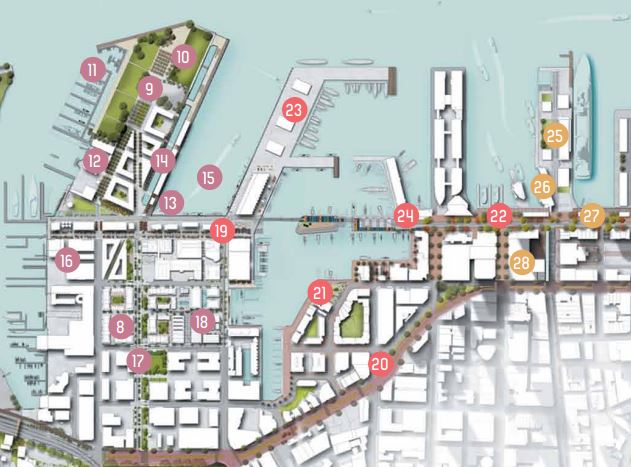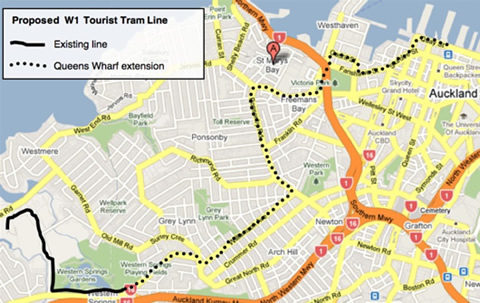The ARC is supporting the idea of a waterfront tram, however the City transport chairman Ken Baguley prefers “some form of electric shuttle buses”. This is disappointing, but unsurprising. Auckland City steadfastly refused to endorse trams or light rail when we presented the concept to them last year. Despite light rail being specifically mentioned in Auckland City’s own Waterfront Vision 2040 document, council officers reported back that this was “merely aspirational”. In the end the Auckland City commitee endorsed an “innovative transport solution” for the waterfront. Whatever that is. It is only the Auckland Regional Council that is keeping the hope of a waterfront tram alive at this point.
And it seems hypocritical convenient of Mr Baguley to say “any major decisions should be left to the new Auckland Council to be elected in October, 2010”, having just endorsed the Government’s ill-conceived above ground motorway at Waterview.
Mathew Dearnaley reports in this article in the Herald:
Moves to open Queens Wharf in Auckland to the public are heightening regional council interest in running light railcars or trams along the waterfront to Wynyard Quarter.
Auckland Regional Council transport committee chief Christine Rose said yesterday that the addition of the wharf to the public domain would increase the need for convenient travel between waterfront attractions.
She expected opportunities presented by the transformation of Queens Wharf, which the council and the Government have bought from Ports of Auckland for $40 million for public use and the development of a cruise ship terminal, to be included in a light-rail feasibility study.
Progress is to be reported back to her committee in November.
Ms Rose said that although previous transport planning for Wynyard Quarter and elsewhere had not included light rail, the council wanted to provide more information to all parties involved in redeveloping the waterfront.
The study already begun by council officers would give information on how light rail had been used in comparable waterfront cities, in some cases breathing life into previously run-down precincts such as Docklands in London, and examine the costs of such a system for Auckland.
“We are striving to add to existing heritage and character and to enhance Auckland’s waterfront viability and experience for workers, tourists and Aucklanders at large,” Ms Rose said.
She was attracted to the use of heritage trams from the Museum of Transport and Technology (Motat) as a drawcard for tourists, but
acknowledged there could be a demand for more modern units, depending on whether those were seen as a suitable extension of Auckland’s commutersystem.
Motat runs trams along 2km of lines at Western Spring, and has been working with the Campaign for Better Transport on possibilities for extending its services to the waterfront.
It estimated last year, when a proposal was first put to Auckland City Council, that 4km of high-quality tracks and low-profile power-lines could be laid for about $16 million for use by either heritage trams, modern units, or by a combination of vehicles.
The city’s transport committee asked officers then for a preliminary report but decided in March to wait for findings of a wider study of integrating public transport services within the central business district before making recommendations on options for Wynyard Quarter.
City transport chairman Ken Baguley said yesterday he had no wish to “pooh- pooh” the proposal, but believed questions of how to integrate existing services should be considered first.
Uncertainty remains over whether the proposed Te Wero bridge across Viaduct Harbour will be designed to carry public transport vehicles, rather than just pedestrians and cyclists, and Mr Baguley said some form of electric shuttle buses may prove as attractive as trams.
The city council has delayed the bridge project until 2016 in any case, after its estimated cost rose to $47.3 million, and is considering installing a temporary crossing for $2 million for up to 14,700 pedestrians an hour in time for the 2011 Rugby World Cup.
Although city officers hope to provide recommendations on options early next year for improving public transport integration, Mr Baguley said any major decisions should be left to the new Auckland Council to be elected in October, 2010.



One thought on “Tram rides on waterfront options list”
Well, they had all the rails down there, in fact they had most of central Auckland railed and ready to go with trams, and then some clown in the council decided that the ‘new motorbuses’ were the way to get around and had all the tracks torn up. Now they will have to lay new track and erect new overheads. Is this a case of history repeating itself?